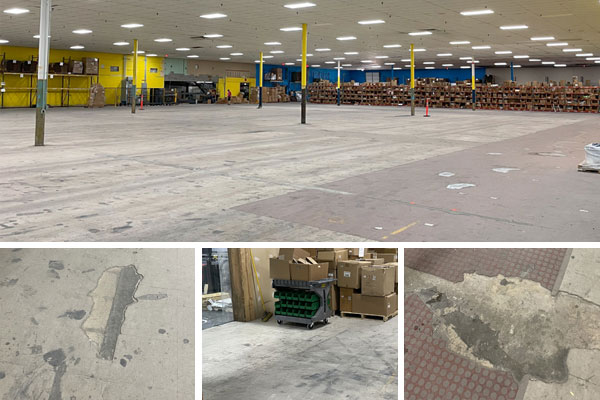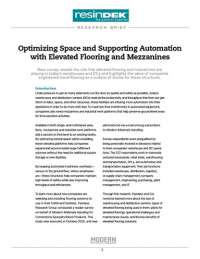While more operations are deploying Automated Guided Vehicles (AGVs) and Autonomous Mobile Robots (AMRs) in their facilities, not every existing ground floor surface can support them. Many existing concrete floors have swales and slopes, cracks and spalling, and surfaces that can’t stand up to repetitive robotic traffic patterns.
Fortunately, ResinDek® panels can be installed directly on top of an existing ground floor. ResinDek is the perfect flooring for industrial robots, the panels create a level floor with surface characteristics that are critical for the successful deployment of robots. Further, they’ve been tested extensively in the labs of numerous AGV and AMR manufacturers, as well as in our own, to confirm the superior durability and wear resistance in robotic applications.
Challenges with robotic deployments on ground floors
With extremely limited traditional warehouse space available, more companies are converting non-traditional square footage into distribution and fulfillment centers. Whether it’s a factory building, an anchor store in a mall, an office building, or a decommissioned public transportation hub, facilities that were never intended to be warehouses are now being used that way. Further, with ongoing workforce challenges, operations are increasingly deploying warehouse robots like AGVs and AMRs to help with material movement throughout multiple processes. Yet, when used on the wrong floor surface, these vehicles simply cannot function. Among the most common ground floor issues that hamper robotic operation are the following:
- Improper coefficient of friction, or surface roughness, prevents the vehicle’s wheels from gaining adequate traction to accelerate, stop, and change directions.
- An Unlevel Surface can cause robots to slow down as they navigate.
- Reflectivity that is either too high or too low interferes with the robots’ navigational sensors.
- Cracks or spalling, which robots cannot traverse over.
- Insufficient wear resistance, wherein repeated robotic traffic patterns damage the floor surface.
So why not use concrete for your warehouse floor?
Concrete is the material most often encountered in these applications. While it may be possible to grind down uneven areas, patch cracks, add a new layer of concrete on top, or apply an epoxy coating over the surface, ultimately, these repairs have multiple drawbacks:
- It takes a considerable amount of time and manual labor to grind down concrete — which also creates a lot of dust.
- Patching often does not match the properties of the original concrete flooring, creating more problems for robot navigation.
- Pouring fresh concrete or an epoxy coating both take extensive amounts of time to dry and set properly, while still not offering the wear resistance robots often require.
- Safety Hazards - Some facilities may have other floor coverings laid over the concrete, such as tiles with asbestos content. Safely removing this material is both dangerous and costly. Further, the surface beneath it will likely be marred by adhesive, as well as scratched and damaged — requiring additional remediation.
Robot-Ready Flooring: Utilizing ResinDek panels over ground floors for robotic applications
Installing ResinDek panels over the ground floor requires some preparation to ensure the surface is level. A digital mapping process is conducted first to document the floor’s variability in elevation and to identify areas that need correction. Slopes and swales are corrected and leveled, cracks are patched sealed, and the existing floor surface is completely leveled. ResinDek panel installation follows a precisely engineered layout provided by Cornerstone Specialty Wood Products.
The layout accommodates any building structure, such as columns. Engineered ResinDek HD or Xspan panels are laid directly over the existing floor — no subfloor material is required. Their tongue-and-groove design allows them to fit together precisely, eliminating any issues with robotic wheel transfer from one panel to the next. Unlike repairing concrete, installing ResinDek floor panels directly over an existing ground floor is faster, cleaner, easier, and more cost-effective. It also creates the optimal flooring surface to support a successful AGV or AMR deployment.
The benefits of ResinDek's flooring system for automated warehouses
- Increased Productivity of Warehouse Operations Durability : ResinDek flooring is highly durable and can withstand heavy rolling loads, including the weight of robotics equipment.
- Electrostatic Dissipative Finish: Our ResinDek flooring for fully autonomous warehouse robots come with static dissipative properties, which is essential in robotics applications where electrostatic discharge (ESD) can damage sensitive electronic components.
- Installation Efficiency: ResinDek flooring systems are designed for efficient installation. The panels can be quickly assembled, reducing downtime during installation and allowing for faster deployment of robotics systems.
- 10-Year Warranty
We can help enhance your automated systems.
Article topics
Email Sign Up


















